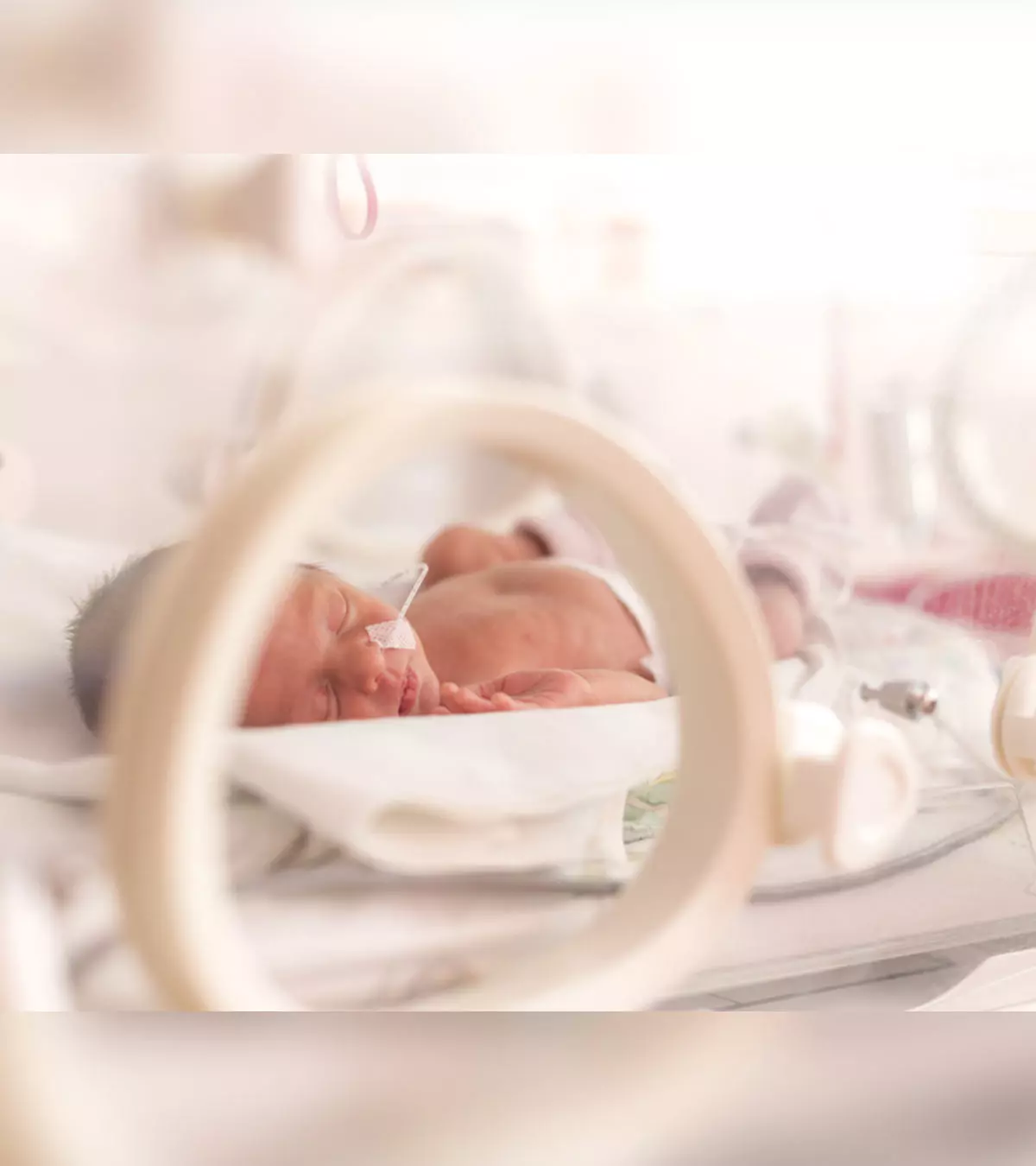

Image: ShutterStock
Neonatal respiratory distress syndrome (NRDS) is a lung disease caused due to deficiency of surfactants in the lungs’ alveoli. The lung disease is also called hyaline membrane disease or infant respiratory distress syndrome (IRDS).

The condition is usually common in premature babies who do not have fully developed lungs. It is less commonly seen in full-term babies (1). Breathing difficulties are common due to NRDS. Thankfully, the disease can be treated before or after the baby’s birth.
Read this post to know the symptoms, risk factors, treatments, and possible complications of neonatal respiratory distress syndrome.
Causes Of Neonatal Respiratory Distress Syndrome
NRDS is caused by the deficiency of pulmonary surfactants present in the alveolar spaces of the lungs. Pulmonary surfactants are slimy, mucus-like substances made of proteins and lipids. The surfactant lines the air sacs (alveoli) to reduce the surface tension, thus helping the lungs stay inflated and preventing their collapse (2).
Image: Shutterstock
Usually, the fetus starts to produce surfactants between 24 and 28 weeks of gestation, and most babies can breathe normally by 34 weeks of pregnancy. Babies born earlier than this time may not have enough surfactants to keep their lungs inflated and might experience NRDS (2).
Factors That Increase The Risk of NRDS
Although NRDS mostly affects premature babies, it could also occur in full-term infants. The following gestational and maternal factors increase the risk of NRDS in infants (3).
- Premature birth
- Maternal diabetes
- Low birth weight
- Immature lungs at birth
- Problems in breathing at birth (birth asphyxia)
- Multiple births or twins
- C-section delivery without labor
- Prenatal infections
- Siblings had NRDS
Some other problems or complications at birth, such as congenital heart defects, may also increase the risk.
Premature birth before 37 weeks is usually the leading risk factor (3) (4). According to NHS, about half of the babies born between 28 and 32 weeks develop NRDS (2). NRDS risk is usually reduced by the advancing gestational age with a 50% risk at the 28th week of gestation and a 5% risk at 37th week and longer (1).
Signs And Symptoms Of Neonatal Respiratory Distress Syndrome
A newborn with NRDS often displays symptoms immediately after birth or within minutes after birth. The condition gradually gets worse for two to four days after birth. You may notice the following signs and symptoms in babies who have NRDS (5).
- Blue lips, toes, and fingers (cyanosis)
- Apnea (brief pause in breathing)
- Chest retractions (skins pulls between ribs while breathing)
- Shallow or rapid breathing
- Grunting or noisy breathing
- Nasal flaring (widening of nostrils)
Seek emergency medical care if you notice symptoms of NRDS in your baby. Usually, if your baby has RDS, he/she will be shifted to ICU straight after birth.
Diagnosis Of NRDS
The following tests are often ordered after a physical examination to confirm or rule out the diagnosis of NRDS (5).
- Blood tests may help determine the presence of infection and the amount of oxygen in the blood.
- Pulse oximetry uses a sensor device on a finger, toe, or ear to display the oxygen levels in the blood.
- Chest X-ray may show a cloudy appearance of lungs in NRDS.
- Echocardiogram is often used to rule out congenital heart defects.
Note
: Although it may have similarities in name and symptoms, acute respiratory distress syndrome (ARDS) is a condition different from neonatal respiratory distress syndrome. ARDS causes rapid onset of respiratory failure with fluid build-up in the air sacs (alveoli). This condition affects adults and children and is commonly caused by sepsis, pneumonia, COVID-19, and chest injury, to name a few (4).
Treatment For Neonatal Respiratory Distress Syndrome
The main goal of treatment is to help the baby to breathe easily (2).
1. Treatment before birth
If a woman is at risk of delivering before 34 weeks, then she may be administered corticosteroid injections, which hasten the baby’s lung development before birth. Other medicines may also be injected to delay labor or reduce the risk of developmental problems associated with premature birth.
2. Treatment after birth
Babies with NRDS are transferred to a neonatal intensive care unit soon after the delivery. Extra oxygen is given through an incubator or tubes in mild cases, whereas ventilator (breathing machine) support is required for babies with severe symptoms. Artificial surfactants are also provided through the breathing tubes.
Treatment within two hours of birth is shown to be more beneficial than delayed interventions. Intravenous fluid and nutrition are given to babies who are on ventilators. Mild cases may require breathing support for a few days, and extremely premature babies may need breathing support for weeks or months, depending on their lung maturity.
Possible Complications Of NRDS
Although most babies with NRDS are treated on time, they may have a higher risk of developing the following complications in later life (2).
- Pneumothorax is the leakage of air from the lungs into the chest cavity. This may increase the risk of lung collapse due to increased pressure.
- Internal bleeding such as pulmonary hemorrhage (bleeding inside the lungs) and intraventricular hemorrhage (bleeding inside the brain) may occur in infants with NRDS.
- Bronchopulmonary dysplasia (BPD) is lung scarring that may occur due to oxygen supplementation and administration of surfactants. It is often seen in babies who received ventilation within 24 hours of birth. These babies need oxygen support for a long time.
- Developmental disabilities may occur if the baby experiences brain damage due to bleeding or oxygen deficiency. Learning problems, impaired vision and hearing, and movement difficulties are common disabilities associated with NRDS.
Babies with complications require relevant treatment and may spend more days in the hospital. Long-term observation might be required to determine any developmental problems.
Prevention Of Neonatal Respiratory Distress Syndrome
Proper prenatal care helps reduce the risk of NRDS at birth. Regular follow-up during the prenatal period may help identify the risk of premature birth and prevent it to an extent.
Although premature birth cannot be avoided in some situations, precautionary treatment, such as corticosteroid injections, may help reduce the risk of NRDS in babies. In cases where NRDS is not prevented, precautionary medications may reduce the severity of the syndrome and its associated complications (6).
Frequently Asked Questions
1. Is newborn respiratory distress syndrome fatal?
The newborn respiratory syndrome gets better in most babies with timely respiratory support and intensive care. It can be life-threatening in some infants with severe respiratory distress or delay in interventions. Most fatalities occur between the second and the seventh day of life (3) .
2. How long does respiratory distress syndrome last in a newborn?
Respiratory distress syndrome may last for a few days, and usually, the condition can worsen in the first two to four days but gradually gets better with adequate treatment. Lack of enough oxygen supply to the brain or severe immaturity of the lungs can lead to brain and lung damage. Sometimes, babies may get complications of treatments, such as the delivery of high-pressure oxygen to the lungs (3).
Neonatal respiratory distress syndrome (NRDS) is a medical condition causing breathing problems in babies. It is usually seen in preterm infants due to their underdeveloped lungs and lack of lung surfactants. If your newborn has this syndrome, your doctor may move them to the intensive care unit to offer support for their breathing and prompt medical care. To prevent this condition in your baby, ensure you do regular prenatal visits to discuss any possible abnormalities with your doctor, evaluate the risk of premature birth and NRDS, and facilitate timely precautionary treatments.
Key Pointers
- A deficiency of pulmonary surfactants leads to neonatal respiratory distress syndrome (NRDS).
- Premature birth, maternal diabetes, or C-section delivery without labor may increase the risk of NRDS.
- Symptoms in babies include blue lips, chest retractions, rapid breathing, grunting, and nasal flaring.
- Treatment before birth involves taking corticosteroid injections, and post-birth, the baby may have to be put on a ventilator.
- NRDS can be prevented with proper prenatal care.
References
1. Janet Dyer; Neonatal Respiratory Distress Syndrome: Tackling A Worldwide Problem;; NCBI
2. Newborn respiratory distress syndrome;; NHS UK
3. Neonatal respiratory distress syndrome (RDS); U.S. National Library of Medicine
4. Respiratory Distress Syndrome, Infant; National Organizations for Rare Disorders
5. Respiratory Distress Syndrome;; National Heart, Lung, and Blood Institute
6. Respiratory Distress Syndrome (RDS) in Premature Babies; Lucile Packard Children’s Hospital; Stanford Children’s Health
Community Experiences
Join the conversation and become a part of our nurturing community! Share your stories, experiences, and insights to connect with fellow parents.
Read full bio of Dr. Anuradha Bansal
Read full bio of Dr Bisny T. Joseph















